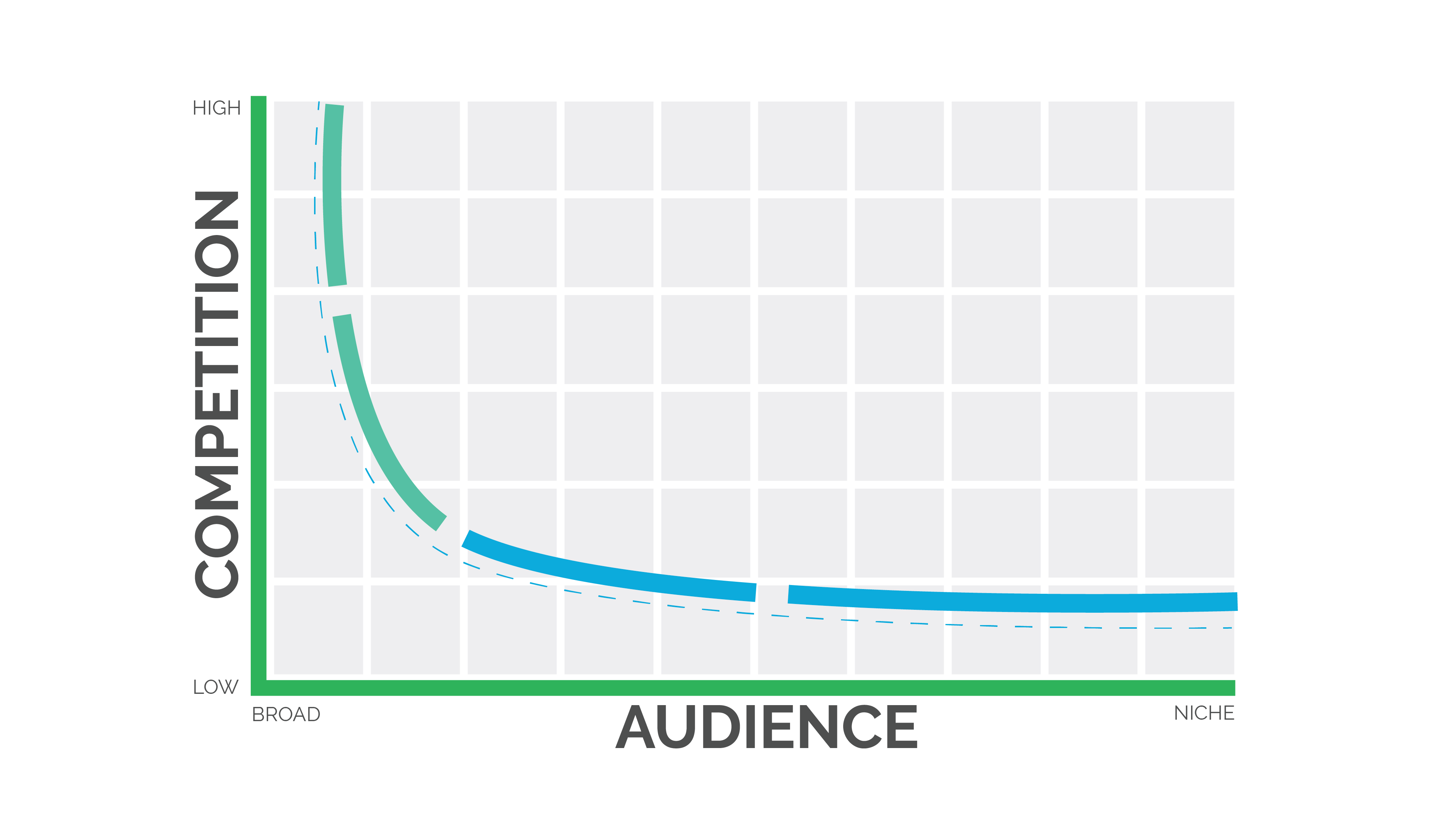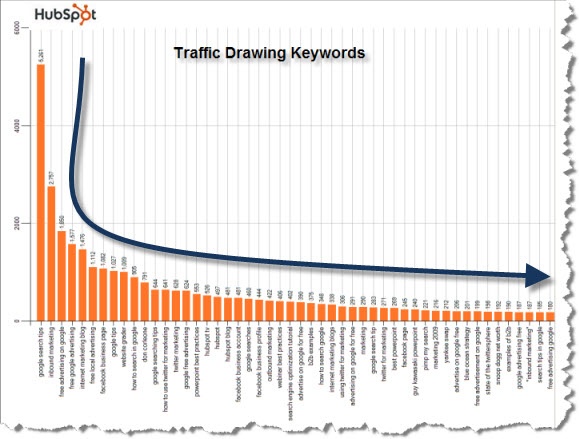Back in 2004, Chris Anderson of Wired Magazine popularized the statistical term “long tail” for online marketers, explaining that in an era of unlimited web “shelf space,” products that have a low sales volume could collectively earn a market share exceeding that of the comparatively few high-volume products, if the distribution channel were large enough.
At a time when Amazon was on course to overtake Walmart as the most powerful retailer in the world (it surpassed Walmart in market cap in 2015), it was hard to argue Anderson’s point. Since that time, the long tail has emerged as a key consideration for digital marketing strategists in an environment of ever-increasing media fragmentation and niche marketing.
Long-Tail Media and Its Impact on PR and Advertising
What do we mean by "media fragmentation"? It basically means that smaller audiences are consuming broad-market media and that more and more consumers are receiving their information from niche sources. This would suggest that advertisers are better off investing in long-tail advertising, across many websites rather than a few, and that public relations firms must focus on media relations strategies that go well beyond Forbes and "Good Morning, America."
I recently spoke with a PR practitioner who told me that in working to drum up attendance at a local tech event, achieving coverage in the local newspaper and business weekly was incredibly labor-intensive, but that ultimately the event could track no registrations to that news coverage. On the other hand, securing a mention in the email newsletter of a local tech association was one of the key drivers of registrations and helped make the event a success.
Odds are, wherever you live, your local newspaper has less influence than it did last year at this time, and a fraction of what it had 10 years ago. It also has less staff, which makes it harder for a modern PR practitioner to earn a placement. Every day you focus on high-competition general-interest media, you are spending more time to achieve less impactful results. That time is generally better spent identifying the broad continuum of media, influencers and other resources that can most efficiently advance your client or company's third-party validation strategy.
On the media buying side, the long-tail strategy of buying diverse media to reach a target audience is increasingly the default strategy of advertising firms—although it has not been without its hiccups. More than a few brands have been embarrassed by some of the disreputable sites where their ads have appeared, and as a result are seeking ways to balance long-tail strategies with so-called "brand safety concerns." It's an ongoing battle.

Niche marketing, Personalization and Long-Tail SEO
One of the first niche marketing success stories was Pepsi Cola's historic efforts to reach the African-American community in the late 1940s; it helped establish the company as the No. 1 rival to Coca-Cola. Much more recently, Facebook founder Mark Zuckerberg launched his site with a niche marketing strategy, focusing first on Harvard, then Ivy League universities, then the broader college student audience before taking over the world.
Today, niche marketing is more directed to the individual consumer than ever before, because technology increasingly enables us to deliver highly targeted experiences. Facebook's various privacy scandals and GDPR notwithstanding, this trend appears to be inexorable. Steven Spielberg's "Minority Report"-style personalization —"John Anderton, you could use a Guinness right about now!"—will surely be part of our future in one form or another.
The way to think about niche marketing and the long tail today is fairly well encapsulated in the world of search presence optimization. Whereas in the past, SEO professionals focused on helping their companies or clients rank on the first page of Google for high-competition keywords, today the smarter strategy is to build a site that will be visible across dozens or hundreds of long-tail keyword searches that will attract more targeted customer segments with less competition.
Today, a full 14 percent of search queries are phrased as questions. As SEO guru Rand Fishkin has reported:
The long tail is still very long indeed, with a huge amount of search volume taking place in keywords outside the top 10 million most-searched-for queries. In fact, almost 25% of all search volume happens outside the top 100 million keywords!

Search engines are always collecting data on user preferences and the keywords that we use. By tapping into this reservoir of information, businesses can tailor their systems to serve up relevant search results when long-tail keywords are searched for.
Bigger organizations can invest in their own recommendation systems. Using state-of-the-art AI tools, these systems can intelligently learn customer behavior and tailor product recommendations to niche audiences based on their past purchase records and general preferences.
How Tech Giants are Using Long-Tail Marketing
Two of the best-known examples of long-tail marketing in the tech world are that of Netflix and Amazon. These companies have made effective use of long-tail marketing strategies to sell content and products that do not receive widespread attention.
Netflix and the Movies You Didn't Know About
Netflix’s growth from a DVD distributor to an online streaming giant is an inspiring tale in itself. However, the company's use of long-tail marketing to drive views towards the less popular portions of their catalog is equally impressive. When you search for a movie or TV show on Netflix, odds are that even if the content you’re looking for is not on the platform, their system will recommend shows or movies that have similar themes. Some of these titles will likely be unknown to you, but you may be interested in checking them out anyway because of the subject matter, star, genre or other similarities. Netflix has a recommendation for everything, largely because of how intelligently they catalog their collection and utilize AI to learn user behavior. Consequently, even the least popular titles on Netflix may crop up in your searches when the stars align.
Amazon and What People Also Buy
As a Big 5 tech company, Amazon is a juggernaut in the e-commerce space and needs no introduction. But what we often ignore in our haste to checkout is how Amazon cleverly markets an endless stream of complementary products in their inventory during the buying process. When you are on the product page of any item, there are sections to show you products that people also buy, along with related products and products with four- and five-star reviews. These are items Amazon recommends based on your purchase, often including dozens of products you can scroll through. These sections are typically sponsored by vendors that pay Amazon to include their products. Leave it to Amazon to turn long-tail marketing into an opportunity to make money from both buyers and sellers.
Long-Tail E-Commerce and the Physical World
When long-tail strategies cross over from the virtual realm to the physical world, logistical considerations, such as warehousing costs, are critical. "Shelf space" is unlimited in online stores but not in the real world. That's why many long-tail sellers rely on centralized warehousing or shipping directly from manufacturers to reduce costs.
A significant portion of the success of a long-tail e-commerce model rests on the availability of niche products. If a product is not in stock when a customer orders it, it not only amounts to a loss of sales but also a loss of brand trust. A top-notch inventory management system ensures that even the longest of long-tail items can be shipped at a moment’s notice.
Before the emergence of the long tail in e-commerce, retailers typically could count on their most popular items to drive 80% of sales. Today research indicates that figure is closer to 50%, as more customers seek out the niche products they want most rather than settling for popular products that aren't their first choice.
From e-commerce to SEO, media-buying to PR, you can expect to continue seeing more charts shaped like a long tail in the future. It's the hockey-stick chart of modern digital marketing.

 7 min read
7 min read






 10 min read
10 min read

